Module 11 Body language Unit 1 They touch noses! 课件(共33张PPT)
文档属性
| 名称 | Module 11 Body language Unit 1 They touch noses! 课件(共33张PPT) | 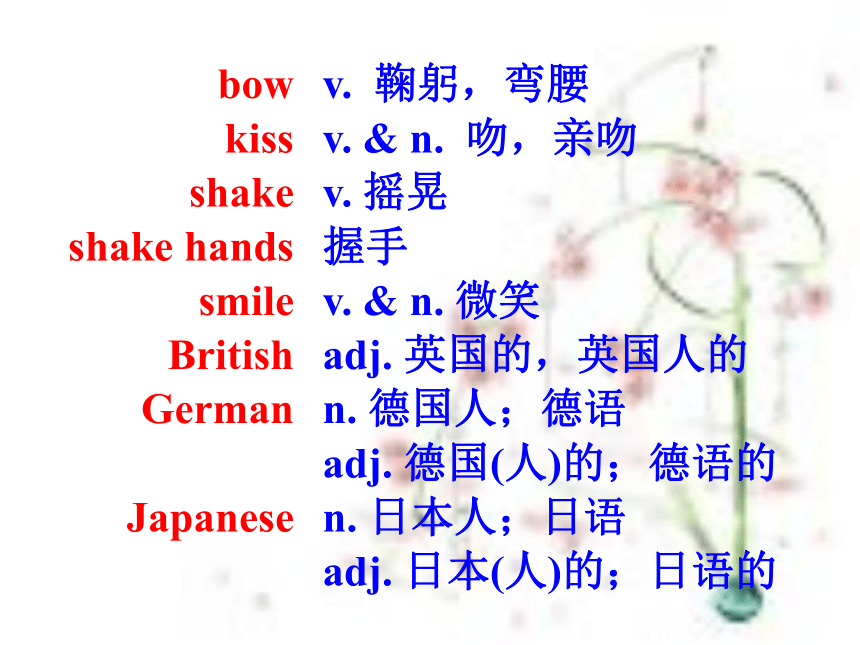 | |
| 格式 | zip | ||
| 文件大小 | 4.2MB | ||
| 资源类型 | 教案 | ||
| 版本资源 | 外研版 | ||
| 科目 | 英语 | ||
| 更新时间 | 2020-06-05 08:17:05 | ||
图片预览


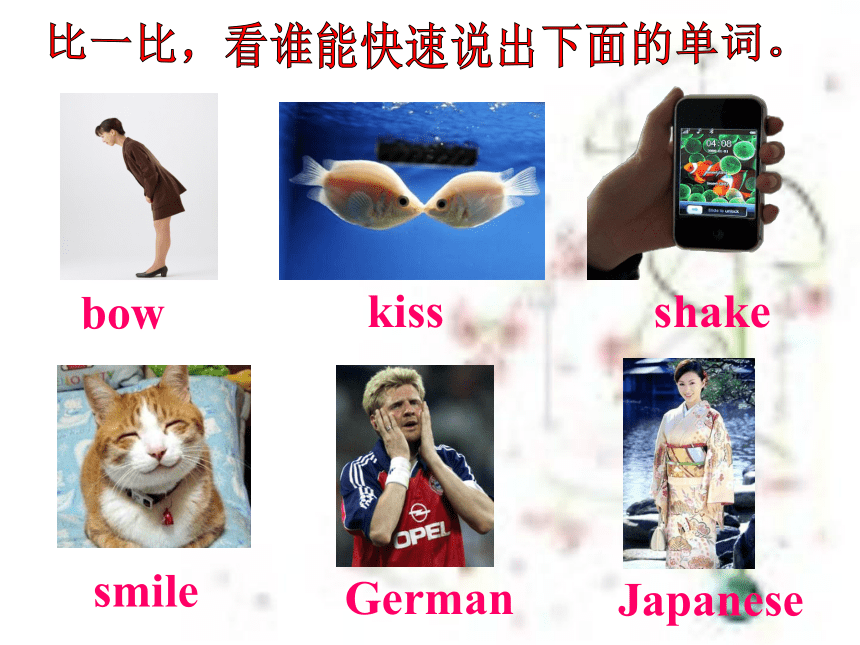
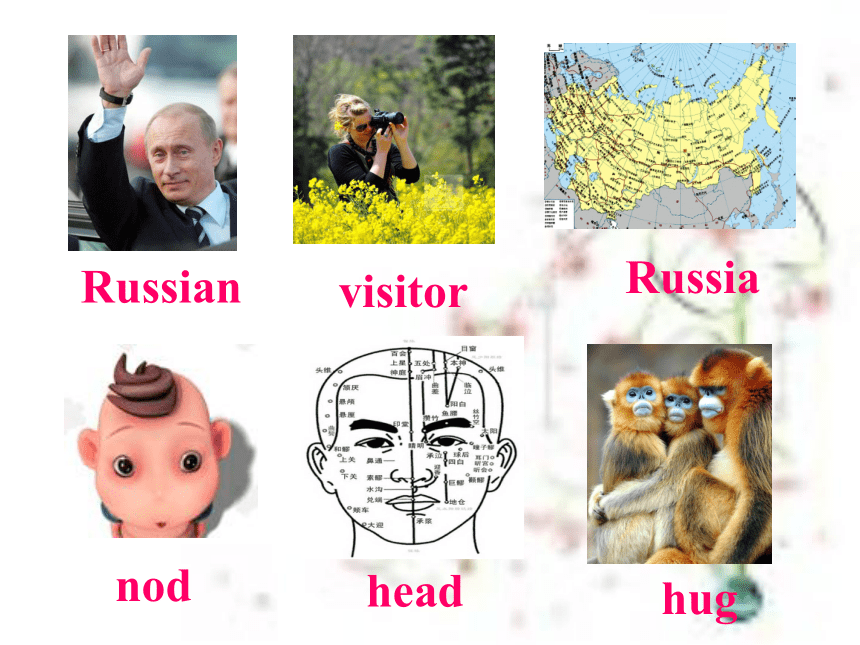
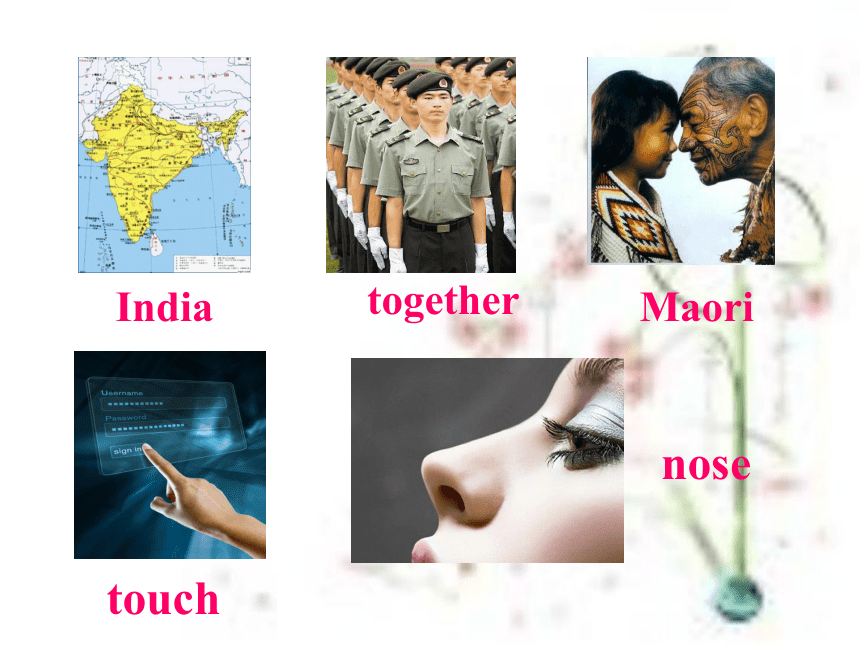
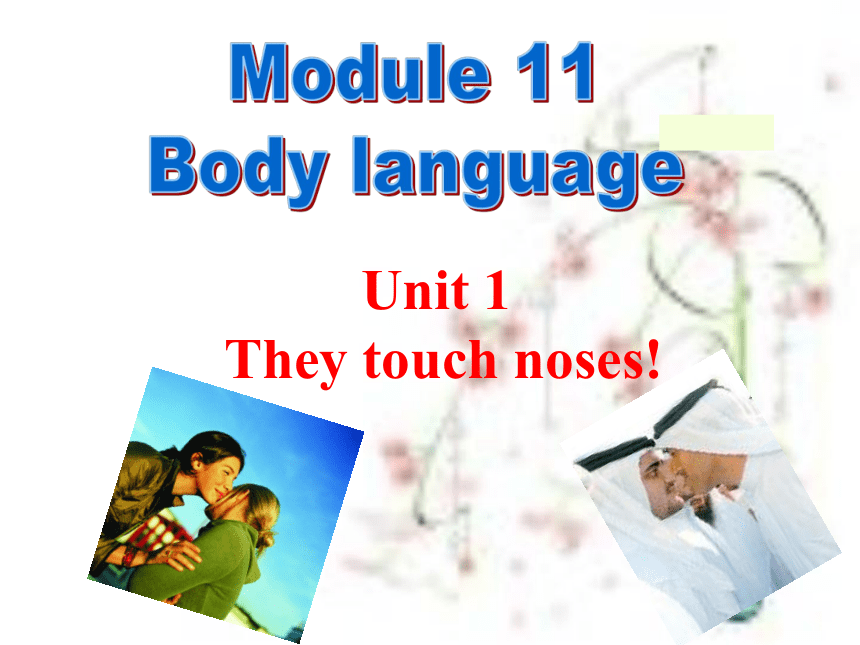
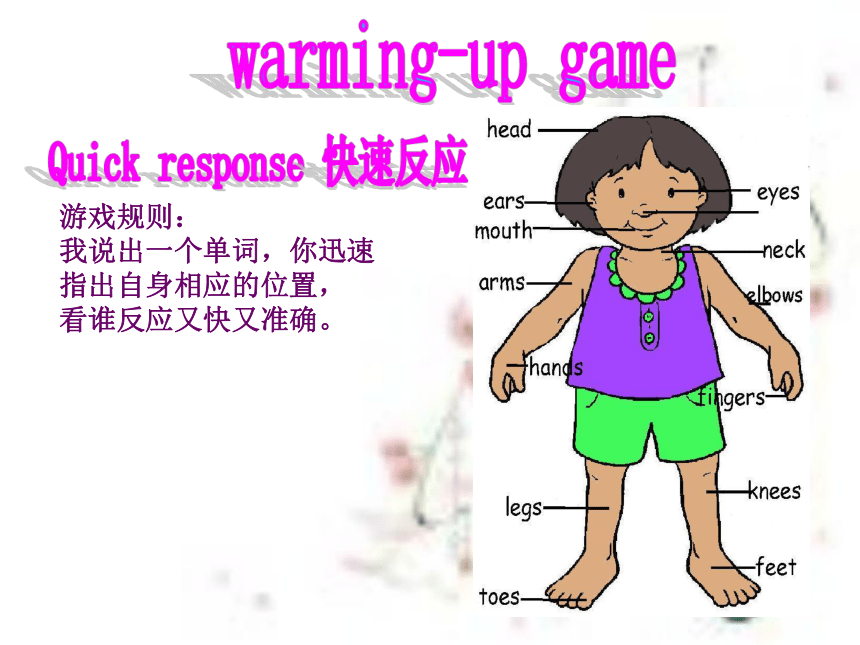
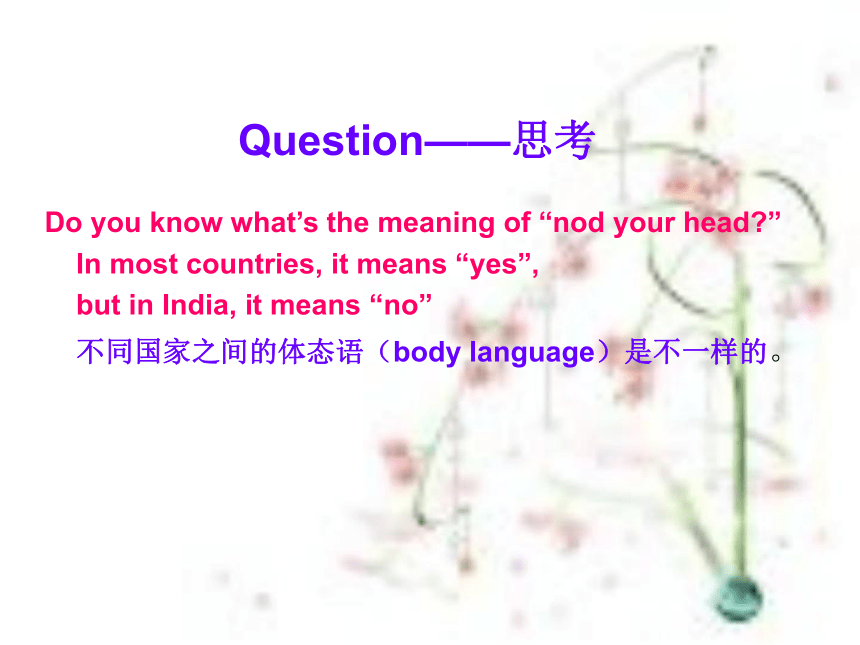


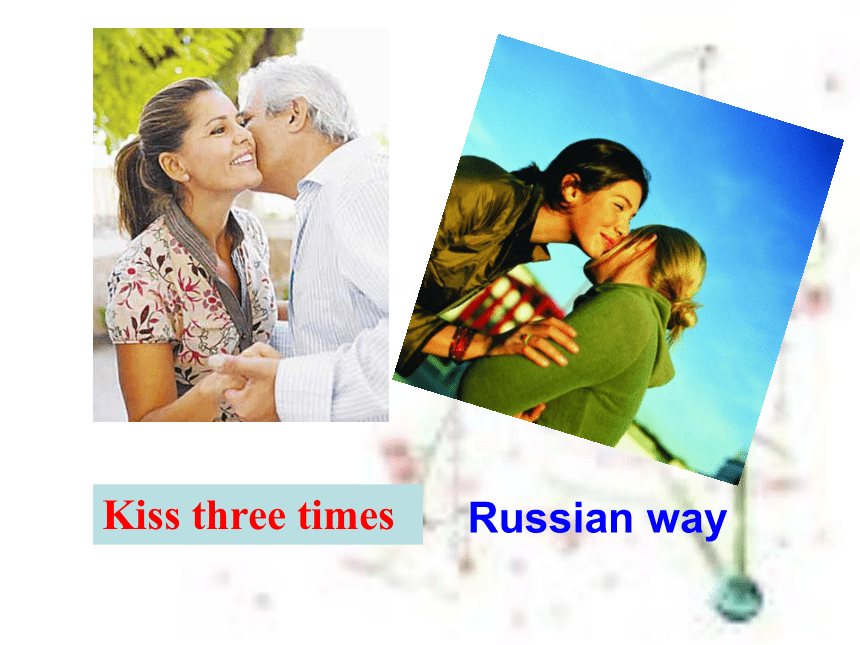

文档简介
(共33张PPT)
bow
kiss
shake
shake
hands
smile
British
German
Japanese
v.
鞠躬,弯腰
v.
&
n.
吻,亲吻
v.
摇晃
握手
v.
&
n.
微笑
adj.
英国的,英国人的
n.
德国人;德语
adj.
德国(人)的;德语的
n.
日本人;日语
adj.
日本(人)的;日语的
visitor
Russia
what
nod
head
hug
each
each
other
India
together
Maori
touch
nose
n.
游客,观光者
n.
俄罗斯
int.
什么(表示惊奇)
v.
点(头)
n.
头,头部
v.
拥抱,紧抱
pron.
各个,每个
互相;彼此
n.
印度
adv.
一起;共同
adj.
毛利人的
v.
触摸;接触
n.
鼻子
bow
kiss
shake
smile
German
Japanese
Russian
visitor
Russia
nod
head
hug
India
together
Maori
touch
nose
Unit
1
They
touch
noses!
游戏规则:
我说出一个单词,你迅速
指出自身相应的位置,
看谁反应又快又准确。
Do
you
know
what’s
the
meaning
of
“nod
your
head?”
In
most
countries,
it
means
“yes”,
but
in
India,
it
means
“no”
不同国家之间的体态语(body
language)是不一样的。
Question——思考
People
from
different
countries
have
different
ways
of
body
languages
to
greet
each
other.
Look
at
the
following
pictures.
Chinese
way
Shake
hands
and
smile
Russian
way
Kiss
three
times
American
way
Shake
hands,
kiss
or
hug
Indian
way
Put
hands
together
and
nod
heads
Maori
people
Touch
noses
课标解读
了解不同国家初次见面和表达问候时的身势语,增强国际意识,尊重他国文化,明白包括身势语在内的语言在国际交流中的重要性。
Learning
aims
1.
Memorize
12
key
words
and
8phrases
in
M11;
be
able
to
make
suggestions
using
imperative
sentences.
2.
Learn
to
use
correct
body
language
when
meeting
foreigners
by
cooperation
and
discussion.
3.
Know
more
about
the
differences
in
body
languages
and
show
your
respect
to
different
cultures.
Match
the
pictures
with
the
words
and
expression
from
the
box.
bow
(
)
kiss
(
)
shake
hands
(
)
smile
(
)
Listen
and
match
the
pictures
with
the
nationality.
British
(
)
French
(
)
German
(
)
Japanese
(
)
Russian
(
)
Listen
and
read.
Discussion(8分钟)
要求:1)小组长分配好任务,控制好时间。
2)先一对一讨论,再小组内集体讨论,动口
动脑动笔。
内容
要求
Step1完成表格
理清文章脉络
——书面展示(在前黑板)
Step2课本剧展示
小组长带领分好工,认真完成!
——口头展示
梳理文章脉络
In
Russia
People
usually
_____
______
times.
In
China
People
______
______
and
______.Sometimes
we
_____
our
______.
In
the
US
People_______
_______,
_______
or
______
each
other.
In
India
People
______
their
_____
together
and
_____
their
_____.
In
New
Zealand
Maori
people
________
________.
Presentation—精彩展评
口头展示:自然,大方,尽量模仿Flash中语音语调,看哪个组
表现最自然
书面展示:看哪个组书写既认真有准确,又有条理
点评同学:
要言简意赅,重点点拨方法技巧
,并适当补充、扩展
内容
Step1完成表格
Step2课本剧展示
展示
点评
G2/G8(B层)
G1(A层)
自由展示
梳理文章脉络
In
Russia
People
usually
_____
______
times.
In
China
People
______
______
and
______.Sometimes
we
_____
our
______.
In
the
US
People_______
_______,
_______
or
______
each
other.
In
India
People
______
their
_____
together
and
_____
their
_____.
In
New
Zealand
Maori
people
________
________.
Imitation——模仿对话
小组表演课本对话中的情景,尽量能背诵下来,注意模仿语音,语调。
看看哪个小组表演最流畅最自然?
Exercise
I.
根据首字母及句子意思,填入恰当的词。
1.
“Welcome!”,
she
s_____
hands
and
smiles.
2.
She
came
and
gave
her
grandpa’s
a
h__.
3.
If
you
agree
my
ideas,
you
n__
your
head.
4.
Maori
people
in
New
Zealand
t____
noses
when
they
meet.
5.
They
b__
to
their
king
every
morning.
hakes
ug
od
ouch
ow
II.
根据今天所学内容,完成短文。
In
_____,
people
shake
hands
and
smile
when
they
meet
visitors.
In
______________,
people
shake
hand
and
sometimes
kiss.
In
_____,
people
put
their
hand
together
and
nod
their
heads.
In
______,
people
usually
kiss
three
times,
In
___________,
Maori
people
touch
noses.
China
America/the
US
India
Russia
New
Zealand
Thank
you,
bye!
1.
…
in
Russia,
people
usually
kiss
three
times,
left,
right,
left.
……在俄罗斯,人们通常亲吻三次,左、右、左。
kiss
v.
吻,亲吻
The
mother
kissed
the
sleeping
baby
on
his
head.
kiss
n.
吻
He
threw
me
a
kiss
and
went
away.
Language
points
2.
That’s
because
people
do
different
things
in
different
countries.
那是因为不同国家的人们做法不同。
that’s
because
…是一个常用句式,表示
“那是因为……”,例如:
That’s
because
you
were
not
careful
enough.
那是因为你不够仔细。
That’s
because
I
didn’t
know
much
about
body
language
in
this
country.
那是因为我对这个国家的肢体语言了解不够。
3.
They
touch
noses!
他们互相碰鼻子!
碰鼻礼是毛利人传统的打招呼方式,也是一种表达真挚问候的礼仪。行礼时,相互问候的两个人要鼻尖相碰,表示交换双方的呼吸,使之融合在一起。毛利人是新西兰的原住民,他们有自己独特的生活方式和文化。
We
Chinese
often
shake
hands
and
smile.
shake
hands
表示“握手”。
Shake
hands
with
sb.
表示“和某人握手”。
2.
名词的复数:
German
→
Germans
Japanese
→
Japanese
Russian
→
Russians
3.
And
some
kiss
or
hug
each
other.
each
other
表示“彼此,互相”,
通常放
在动词后。
4.
In
India
people
put
their
hands
together
and
nod
their
heads.
put
…
together
表示“把……放在一起”。
5.
They
touch
noses!
touch
noses
表示“碰鼻子”。
6.
That’s
because
people
do
different
things
in
different
countries.
That’s
because
…
表示“那是因为……”。
bow
kiss
shake
shake
hands
smile
British
German
Japanese
v.
鞠躬,弯腰
v.
&
n.
吻,亲吻
v.
摇晃
握手
v.
&
n.
微笑
adj.
英国的,英国人的
n.
德国人;德语
adj.
德国(人)的;德语的
n.
日本人;日语
adj.
日本(人)的;日语的
visitor
Russia
what
nod
head
hug
each
each
other
India
together
Maori
touch
nose
n.
游客,观光者
n.
俄罗斯
int.
什么(表示惊奇)
v.
点(头)
n.
头,头部
v.
拥抱,紧抱
pron.
各个,每个
互相;彼此
n.
印度
adv.
一起;共同
adj.
毛利人的
v.
触摸;接触
n.
鼻子
bow
kiss
shake
smile
German
Japanese
Russian
visitor
Russia
nod
head
hug
India
together
Maori
touch
nose
Unit
1
They
touch
noses!
游戏规则:
我说出一个单词,你迅速
指出自身相应的位置,
看谁反应又快又准确。
Do
you
know
what’s
the
meaning
of
“nod
your
head?”
In
most
countries,
it
means
“yes”,
but
in
India,
it
means
“no”
不同国家之间的体态语(body
language)是不一样的。
Question——思考
People
from
different
countries
have
different
ways
of
body
languages
to
greet
each
other.
Look
at
the
following
pictures.
Chinese
way
Shake
hands
and
smile
Russian
way
Kiss
three
times
American
way
Shake
hands,
kiss
or
hug
Indian
way
Put
hands
together
and
nod
heads
Maori
people
Touch
noses
课标解读
了解不同国家初次见面和表达问候时的身势语,增强国际意识,尊重他国文化,明白包括身势语在内的语言在国际交流中的重要性。
Learning
aims
1.
Memorize
12
key
words
and
8phrases
in
M11;
be
able
to
make
suggestions
using
imperative
sentences.
2.
Learn
to
use
correct
body
language
when
meeting
foreigners
by
cooperation
and
discussion.
3.
Know
more
about
the
differences
in
body
languages
and
show
your
respect
to
different
cultures.
Match
the
pictures
with
the
words
and
expression
from
the
box.
bow
(
)
kiss
(
)
shake
hands
(
)
smile
(
)
Listen
and
match
the
pictures
with
the
nationality.
British
(
)
French
(
)
German
(
)
Japanese
(
)
Russian
(
)
Listen
and
read.
Discussion(8分钟)
要求:1)小组长分配好任务,控制好时间。
2)先一对一讨论,再小组内集体讨论,动口
动脑动笔。
内容
要求
Step1完成表格
理清文章脉络
——书面展示(在前黑板)
Step2课本剧展示
小组长带领分好工,认真完成!
——口头展示
梳理文章脉络
In
Russia
People
usually
_____
______
times.
In
China
People
______
______
and
______.Sometimes
we
_____
our
______.
In
the
US
People_______
_______,
_______
or
______
each
other.
In
India
People
______
their
_____
together
and
_____
their
_____.
In
New
Zealand
Maori
people
________
________.
Presentation—精彩展评
口头展示:自然,大方,尽量模仿Flash中语音语调,看哪个组
表现最自然
书面展示:看哪个组书写既认真有准确,又有条理
点评同学:
要言简意赅,重点点拨方法技巧
,并适当补充、扩展
内容
Step1完成表格
Step2课本剧展示
展示
点评
G2/G8(B层)
G1(A层)
自由展示
梳理文章脉络
In
Russia
People
usually
_____
______
times.
In
China
People
______
______
and
______.Sometimes
we
_____
our
______.
In
the
US
People_______
_______,
_______
or
______
each
other.
In
India
People
______
their
_____
together
and
_____
their
_____.
In
New
Zealand
Maori
people
________
________.
Imitation——模仿对话
小组表演课本对话中的情景,尽量能背诵下来,注意模仿语音,语调。
看看哪个小组表演最流畅最自然?
Exercise
I.
根据首字母及句子意思,填入恰当的词。
1.
“Welcome!”,
she
s_____
hands
and
smiles.
2.
She
came
and
gave
her
grandpa’s
a
h__.
3.
If
you
agree
my
ideas,
you
n__
your
head.
4.
Maori
people
in
New
Zealand
t____
noses
when
they
meet.
5.
They
b__
to
their
king
every
morning.
hakes
ug
od
ouch
ow
II.
根据今天所学内容,完成短文。
In
_____,
people
shake
hands
and
smile
when
they
meet
visitors.
In
______________,
people
shake
hand
and
sometimes
kiss.
In
_____,
people
put
their
hand
together
and
nod
their
heads.
In
______,
people
usually
kiss
three
times,
In
___________,
Maori
people
touch
noses.
China
America/the
US
India
Russia
New
Zealand
Thank
you,
bye!
1.
…
in
Russia,
people
usually
kiss
three
times,
left,
right,
left.
……在俄罗斯,人们通常亲吻三次,左、右、左。
kiss
v.
吻,亲吻
The
mother
kissed
the
sleeping
baby
on
his
head.
kiss
n.
吻
He
threw
me
a
kiss
and
went
away.
Language
points
2.
That’s
because
people
do
different
things
in
different
countries.
那是因为不同国家的人们做法不同。
that’s
because
…是一个常用句式,表示
“那是因为……”,例如:
That’s
because
you
were
not
careful
enough.
那是因为你不够仔细。
That’s
because
I
didn’t
know
much
about
body
language
in
this
country.
那是因为我对这个国家的肢体语言了解不够。
3.
They
touch
noses!
他们互相碰鼻子!
碰鼻礼是毛利人传统的打招呼方式,也是一种表达真挚问候的礼仪。行礼时,相互问候的两个人要鼻尖相碰,表示交换双方的呼吸,使之融合在一起。毛利人是新西兰的原住民,他们有自己独特的生活方式和文化。
We
Chinese
often
shake
hands
and
smile.
shake
hands
表示“握手”。
Shake
hands
with
sb.
表示“和某人握手”。
2.
名词的复数:
German
→
Germans
Japanese
→
Japanese
Russian
→
Russians
3.
And
some
kiss
or
hug
each
other.
each
other
表示“彼此,互相”,
通常放
在动词后。
4.
In
India
people
put
their
hands
together
and
nod
their
heads.
put
…
together
表示“把……放在一起”。
5.
They
touch
noses!
touch
noses
表示“碰鼻子”。
6.
That’s
because
people
do
different
things
in
different
countries.
That’s
because
…
表示“那是因为……”。
同课章节目录
- Module 1 Lost and found
- Unit 1 Whose bag is this?
- Unit 2 Are they yours?
- Unit 3 Language in use
- Module 2 What can you do ?
- Unit 1 I can play the piano
- Unit 2 I can run really fast
- Unit 3 Language in use
- Module 3 Making plans
- Unit 1 What are you going to do at the weekends?
- Unit 2 We're going to cheer the players.
- Unit 3 Language in use
- Module 4 Life in the future
- Unit 1 Everyone will study at home
- Unit 2 Every family will have a small plane.
- Unit 3 Language in use
- Module 5 Shopping
- Unit 1 What can I do for you?
- Unit 2 You can buy everything on the Internet
- Unit 3 Language in use
- Module 6 Around town
- Unit 1 Could you tell me how to get to the Nationa
- Unit 2 The London Eye is on your right.
- Unit 3 Language in use
- Revision module A
- Module 7 My past life
- Unit 1 I was born in a small village.
- Unit 2 I was born in Quincy.
- Unit 3 Language in use
- Module 8 Story time
- Unit 1 Once upon a time….
- Unit 2 Goldilocks hurried out of the house.
- Unit 3 Language in use
- Module 9 Life history
- Unit 1 He left school and began work at the age of
- Unit 2 He decided to be an actor.
- Unit 3 Language in use
- Module 10 A holiday journey
- Unit 1 What did you do?
- Unit 2 This morning we took a walk.
- Unit 3 Language in use
- Module 11 Body language
- Unit 1 They touch noses!
- Unit 2 Here are some ways to welcome them.
- Unit 3 Language in use
- Module 12 Western music
- Unit 1 It's so beautiful!
- Unit 2 Vienna is the centre of European classical
- Unit 3 Language in use
- Revision module B
